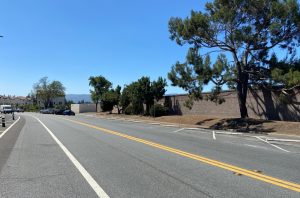Recent raging winter storms have caved in streets, wrecked piers, collapsed homes and apartment buildings, and submerged property up and down California’s coastline.
Now, as sea levels continue to rise from climate change, scientists are working on a real-world experiment that could help reduce the impacts.
At a 247-acre property near the Santa Cruz-Monterey county line, crews are planning to protect against flooding — not by trying to hold back the ocean by building bigger sea walls — but by converting flood-prone farmland into tidal wetlands. During big storms and high tides, this allows ocean waters to move inland in an orderly way instead of threatening homes and other property.
In other words, working with nature, as opposed to trying to battle the ocean’s relentless forward march.
“It’s a demonstration,” said Sarah Newkirk, executive director of the Land Trust of Santa Cruz County, which is overseeing the project. “What we are doing here is applicable to other places in California, the Gulf of Mexico, and other parts of the country.”
On Wednesday, Newkirk’s non-profit environmental group closed a $13.4 million deal to buy the property, known as Beach Ranch. The bucolic farmland sits at the mouth of the Pajaro River near the crashing waves of Monterey Bay, and has flooded multiple of times over the past few generations, most recently this January, and during the previous winter.
A sprawling expanse the size of 187 football fields and covered with neat rows of lettuce, beets, broccoli and other produce, the landscape had been owned for generations by local farming families, including some with connections to major operations, such as Ocean Mist Farms, a Castroville company that is the largest artichoke grower in North America.
The land trust received funding from two state agencies, the California Coastal Conservancy and the Wildlife Conservation Board. It also raised money from Driscoll’s, a major Watsonville strawberry grower. Last month, the project received a $6 million grant from NOAA, the National Oceanic and Atmospheric Administration.
The plan is to convert 65 flood-prone acres and the lowest quality farmland to tidal marshland similar to what existed a century or more ago, while leaving farming on the rest. Scientists from the land trust, the Nature Conservancy, the U.S. Fish and Wildlife Service and other agencies plan to move back existing inadequate dirt levees, build tidal gates, or use other methods.
By creating wetlands, the project aims to create a buffer where flood waters can move in and settle, losing their energy, protecting other nearby farmland and property like Pajaro Dunes, a collection of adjacent oceanfront homes and condominiums.
Part of the farmland purchased by the Land Trust of Santa Cruz County near the Pajaro River in Watsonville, Calif., on Tuesday, Aug. 6, 2024. Scientists will work to build a new oceanfront wetland on the farmland to help reduce the risk of flooding during storms. (Doug Duran/Bay Area News Group)
It also will create a new estuary for birds, fish and other wildlife to help make up for oceanfront wetlands that are expected to be submerged in the coming decades.
“When it rains it gets pretty soggy out here,” Newkirk said during a recent visit. “We are trying to buy and protect habitat where it is going to be. Like Wayne Gretzky said: ‘skate to where the puck is going to be.’”
Sarah Newkirk, the Executive Director of the Land Trust of Santa Cruz County, talks about the land trust purchasing farmland next to the Pajaro River in Watsonville, Calif., on Tuesday, Aug. 6, 2024. Scientists will work to build a new oceanfront wetland on the farmland to help reduce the risk of flooding during storms. (Doug Duran/Bay Area News Group)
The threat of sea level rise is growing.
The 10 hottest years on Earth since modern records began in 1850 all have occurred since 2014, according to NOAA and NASA. The warming climate has caused ocean levels to rise as glaciers and polar ice sheets melt and warming seawater expands. San Francisco Bay and the ocean along California’s coast have risen 8 inches since the mid-1800s.
Recent studies by the U.S. Geological Survey and other scientific organizations estimate that the Pacific Ocean on the West Coast will rise another 1 to 2 feet by 2050 and 4 feet or more by 2100, depending on the amount of greenhouse gasses released into the atmosphere in the coming years.
“This is the biggest dilemma human civilization has had to face,” said Gary Griggs, a distinguished professor of Earth Sciences at UC Santa Cruz, in an interview earlier this year. “Many of the biggest cities in the world are at sea level. Our options are very few. We have to face it. There is absolutely nothing we can do over the long term to hold back the Pacific Ocean.”
Between $8 billion to $10 billion of existing coastal property in California is likely to be underwater by 2050, with an additional $6 billion to $10 billion at risk during high tides, according to a report in 2020 from the state Legislative Analyst’s Office.
Related Articles
Undercover staffers, burial pits and a five-ton mess: How Fremont scrambled to respond to 1,000 dead fish
July was California’s hottest month on record
Five tips to help keep your utility bill somewhat manageable this summer
Wildfires create smoke clouds that hold heat and warm the earth, researchers say
Crews unable to increase containment on Park Fire
In some cases, homes and other oceanfront buildings can be raised. Natural solutions, like offshore reefs, or jetties that stop sand from drifting down the coast, or sand replenishment, can help save beaches, but the sand often washes away in big storms. That leaves sea walls. But those are controversial, because they can cause public beaches to erode. The other option is “managed retreat,” the idea of letting the ocean move inland.
That is very controversial, however, when it involves property with existing homes and businesses, but less so for undeveloped land, like farmland that’s common along the coast, including along San Francisco Bay’s delta.
“This project is very forward thinking,” said Jess Brown, executive director of the Santa Cruz County Farm Bureau. “There’s a cost of farming in areas that are getting flooded. If they can alleviate that, it’s a better solution.”
The land trust will continue to rent the rest of the property to tenant farmers. But there are challenges. Coastal California farmland is expensive. And politics and land use rules vary around the country.
“There are lessons to be learned in this example,” said Noah Diffenbaugh, a professor of Earth system science at Stanford University. “Can it be scaled? In many ways this is where the rubber meets the road in terms of responding and adapting to climate change.”












